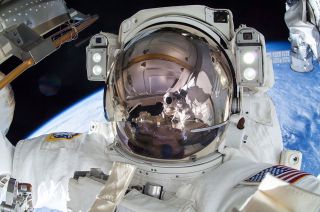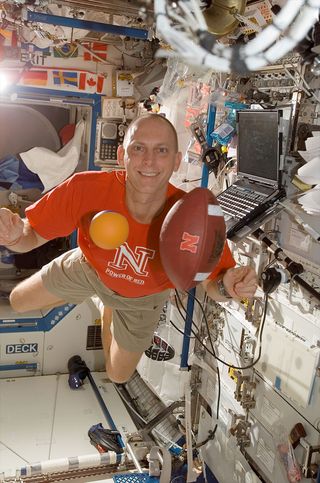How to Make History as a NASA Astronaut Without Walking on Mars

NASA this week announced it would soon begin accepting applicants for its next class of astronauts, enticing potential candidates with the chance to "advance a future human mission to Mars."
But with the space agency's schedules pegging a journey to the Red Planet in the mid-2030s timeframe, it may fall to even more future recruits to become the first astronauts to walk on Mars.
That's not to say there aren't opportunities to make history as a new NASA astronaut. Although there have been more than 365 NASA astronauts to date, there remains firsts to be achieved and all that you have to do to claim them is get chosen for the corps.
With more than 6,000 applications for the last recruitment, being selected may be no small feat. But if you can match the requirements and rise above the rest, you could enter the history books on the same day you report to NASA for basic training. [Related: How to Be an Astronaut]
Born in the USA
NASA states in its requirements that applicants "must be citizens of the United States."
Of course, you needn't be born in the country to be a U.S. citizen (and NASA accepts valid dual-citizenship, too), but if you do hail from the 50 states, you may be able to claim a first by just identifying your birthplace.
In NASA's 56 years of astronaut selections, no candidates have originated from Alaska, Nevada or Wyoming. Some have come close — space shuttle pilot Bill Oefelein grew up in Anchorage after being born in Virginia, for example — but those three remaining states are still without their own homegrown space hero.
Get the Space.com Newsletter
Breaking space news, the latest updates on rocket launches, skywatching events and more!
(There's a fourth state, Vermont, which is the birthplace of a former NASA astronaut who never flew in space, and so the state is still waiting for its first resident to launch.)
So, if you happen to be native-born Alaskan, Nevadian or Wyomian and you become an astronaut, you're likely good as written into the state's history rolls.
Need an example? Clay Anderson, who reapplied 15 times before NASA selected him in 1998, is the first astronaut to come from Nebraska. For that distinction (and his time off the planet), he's been praised by the state's officials, had a documentary tell the story of his life by the state's public broadcasting station and even had Feb. 29, 2008 declared "Clay Anderson Day" in Nebraska.

Professional experience
NASA requires its qualified astronaut candidates to have a bachelor's degree in engineering, mathematics, biological or physical science and have three years of "professional experience" (or 1,000 hours of pilot-in-command time in jet aircraft).
You may believe that limits astronauts to being engineers, medical doctors and military pilots, but there have been a number of space explorers who have come to NASA from unexpected prior employment.
Take, for example, Leland Melvin, who was chosen in the same astronaut class as Anderson. Melvin has degrees in chemistry and materials science engineering, but before he was recruited by NASA, he was drafted by the Detroit Lions to play professional football.
Injuries early in his playing career altered his professional trajectory from the field goal to the frontier, leading Melvin to launch to space on two shuttle missions. To date, he is the only NFL football player orbit the Earth, giving a whole new meaning to "touchdown."
But Melvin is not alone when it comes to astronauts with notable prior professions.
Tom Jones, selected in 1990, spied down on Earth during four spaceflights, but not before working for the CIA. Rick Linnehan had a private veterinary practice before entering NASA's ranks in 1992. Megan Behnken, who was chosen in 2000 and helped service the Hubble Space Telescope, first focused on the seas as an oceanographer.
Mario Runco also studied the oceans prior to entering the astronaut corps in 1987, but even before that he trained at the New Jersey State Police Academy and worked as a state trooper (earning him the nickname "Trooper" later in life).
And then there's Leroy Chiao's first job, serving up meals at McDonald's, 29 years before the fast food chain proudly served him with a Big Mac and french fries on his return to Earth after nearly 200 days aboard the International Space Station.
There are numerous occupations still waiting for their first rep at NASA. You could be the first professional baseball player-turned-astronaut, or perhaps the first paleontologist-turned-flight engineer, or even maybe the first Uber driver-turned-commercial crew spacecraft pilot.
Not born in an astronaut-absent state or hold an unusual job? Continue reading at collectSPACE for more ways NASA’s new astronaut candidates can make space history.
Follow collectSPACE.com on Facebook and on Twitter at @collectSPACE. Copyright 2015 collectSPACE.com. All rights reserved.
Join our Space Forums to keep talking space on the latest missions, night sky and more! And if you have a news tip, correction or comment, let us know at: community@space.com.

Robert Pearlman is a space historian, journalist and the founder and editor of collectSPACE.com, an online publication and community devoted to space history with a particular focus on how and where space exploration intersects with pop culture. Pearlman is also a contributing writer for Space.com and co-author of "Space Stations: The Art, Science, and Reality of Working in Space” published by Smithsonian Books in 2018. He previously developed online content for the National Space Society and Apollo 11 moonwalker Buzz Aldrin, helped establish the space tourism company Space Adventures and currently serves on the History Committee of the American Astronautical Society, the advisory committee for The Mars Generation and leadership board of For All Moonkind. In 2009, he was inducted into the U.S. Space Camp Hall of Fame in Huntsville, Alabama. In 2021, he was honored by the American Astronautical Society with the Ordway Award for Sustained Excellence in Spaceflight History.
